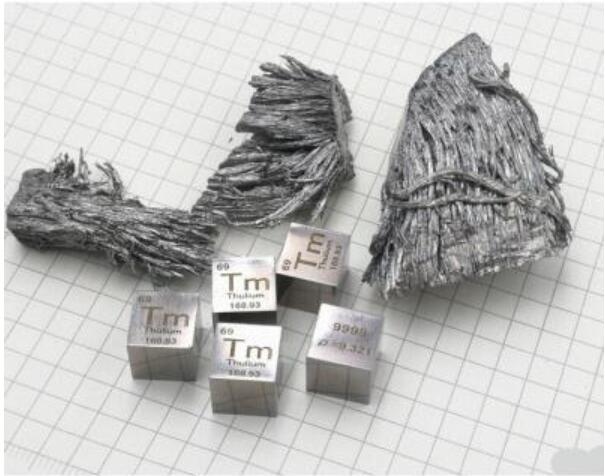Thulium, element 69 of the periodic table.
Thulium, the element with the least content of rare earth elements, mainly coexists with other elements in Gadolinite, Xenotime, black rare gold ore and monazite.
Thulium and lanthanide metal elements coexist closely in extremely complex ores in nature. Due to their very similar electronic structures, their physical and chemical properties are also very similar, making extraction and separation quite difficult.
In 1879, Swedish chemist Cliff noticed that the Atomic mass of erbium soil was not constant when he studied the remaining erbium soil after separating ytterbium soil and scandium soil, so he continued to separate the erbium soil and finally separated out erbium soil, holmium soil and thulium soil.
Metal thulium, silver white, ductile, relatively soft, can be cut with a knife, has a high melting and boiling point, is not easily corroded in air, and can maintain the metal appearance for a long time. Due to the special extranuclear Electron shell structure, the chemical properties of thulium are very similar to those of other lanthanide metal elements. It can dissolve in hydrochloric acid to form a slightly green Thulium(III) chloride, and the sparks generated by its particles burning in air can also be seen on the friction wheel.
Thulium compounds also have fluorescence properties and can emit blue fluorescence under ultraviolet light, which can be used to create anti-counterfeiting labels for paper currency. The radioactive isotope thulium 170 of thulium is also one of the four most commonly used industrial radiation sources and can be used as diagnostic tools for medical and dental applications, as well as defect detection tools for mechanical and electronic components.
Thulium, which is impressive, is the thulium laser therapy technology and the unconventional new chemistry created due to its special extranuclear electronic structure.
Thulium doped Yttrium aluminium garnet can emit laser with wavelength between 1930~2040 nm. When the laser of this band is used for surgery, the blood at the irradiation site will coagulate rapidly, the surgical wound is small, and the hemostasis is good. Therefore, this laser is often used for Minimally invasive procedure of prostate or eyes. This kind of laser has low loss when transmitting in the atmosphere, and can be used in remote sensing and optical communication. For example, Laser rangefinder, coherent Doppler wind radar, etc., will use the laser emitted by thulium doped fiber laser.
Thulium is a very special type of metal in the f region, and its properties of forming complexes with electrons in the f layer have captivated many scientists. Generally, lanthanide metal elements can only generate trivalent compounds, but thulium is one of the few elements that can generate divalent compounds.
In 1997, Mikhail Bochkalev pioneered the reaction chemistry related to divalent rare earth compounds in solution, and found that the divalent Thulium(III) iodide can gradually change back to the yellowish trivalent thulium ion under certain conditions. By utilizing this characteristic, thulium may become the preferred reducing agent for organic chemists and has the potential to prepare metal compounds with special properties for key fields such as renewable energy, magnetic technology, and nuclear waste treatment. By selecting appropriate ligands, thulium can also alter the formal potential of specific metal redox pairs. Samarium(II) iodide and its mixtures dissolved in organic solvents such as tetrahydrofuran have been used by organic chemists for 50 years to control the single electron reduction reactions of a series of functional groups. Thulium also has similar characteristics, and its ligand's ability to regulate organic metal compounds is astonishing. Manipulating the geometric shape and orbital overlap of the complex can affect certain redox pairs. However, as the rarest rare earth element, the high cost of thulium temporarily prevents it from replacing samarium, but it still has great potential in unconventional new chemistry.
Post time: Aug-01-2023
